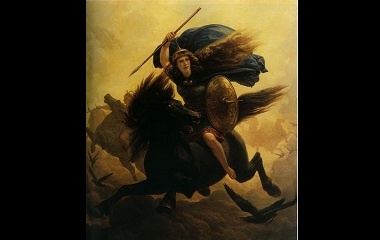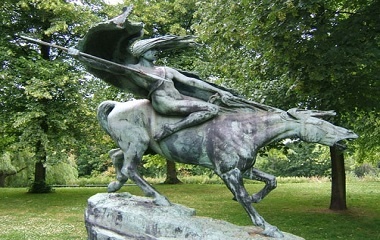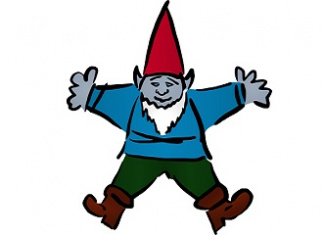What is a Valkyrie?
A Valkyrie is a mortal woman who has had magnificent powers bestowed on her by Odin. These women are responsible for watching over battlefields and collecting the best of the best warriors to make up Odin’s army, which he will unleash during Ragnarok.
Characteristics
Physical Description
The Valkyries’ nobility is reflected in their appearance. They have lily-white skin and statuesque figures. Their hair can be gold as the sunlight or black as the night. During times of peace, these women wear elegant costumes made from swan or raven feathers, but when war draws near, they don their armor: gracefully carved helmets and shields and chain mail corsets. They might continue wearing a feather cape, or, according to some stories, they might sprout wings of their own to help them soar above the battlefields.
Personality
Today, Valkyries are regarded as wise and righteous leaders—but during Norse times, these ladies were a bit more complicated. True, they were highly intelligent, and they loved valor. These traits made them great at choosing heroes to fight alongside Odin in Ragnarok.
Yet, the Valkyries had human weaknesses as well. They were not above showing favoritism on the battlefield, protecting mortals whom they loved or lashing out against mortals who they disliked. Their romances could lead to fits of jealousy or revenge. And some of them, who simply enjoyed the carnage of the battlefield, provoked fights among mortals when they got bored.
Special Abilities
It’s difficult to know exactly how powerful the Valkyries were. Most of them were mortal humans, daughters of royals or great warriors. However, they worked closely with Odin, ruler of the gods, and they clearly had some magical powers.
First and foremost, the Valkyries influenced the fate of warriors and battles (with Odin’s approval, of course). Some stories describe them working at magical looms—with intestines for threads, heads for weights, and swords and arrows for beaters—where they wove the destiny of each fighter into a tapestry that would determine the outcome of the whole battle. Other stories describe them riding horses through the clouds above an active battle. During the battle, they might swoop down to protect a warrior who shouldn’t die. Or they might come down to collect the body of a fallen warrior and carry it off to Valhalla, Odin’s hall, to prepare for the apocalyptic battle of Ragnarok.
Although numerous stories hint that the Valkyries have superhuman strength, they are not allowed to fight alongside human in a battle. They can only use magical powers to influence the battle. The Valkyries may have superhuman foresight as well; they often appear above battlefields days before the fighting begins, and they sometimes deliver prophecies to other mortals.
Finally, the Valkyrie are well-known for serving and brewing mead. Not only is their mead delicious, it has magical properties that can make men stronger, improve their memory, or heal their wounds.
Famous Valkyries
Brynhildr
Not only was Brynhildr beautiful and clever, she was the daughter of a legendary Norse king. Not surprisingly, Odin decided to make Brynhildr one of his Valkyries when she came-of-age.
Brynhildr made a splendid Valkyrie until Odin asked her to decide the fate of a battle between two kings. The young lady knew that Odin preferred the older king, yet she decided to let the younger king win, reasoning that the older king would soon die anyway. Unfortunately, Odin didn’t accept Brynhildr’s reasoning. He was outraged by her decision and decided to imprison her on a mountaintop, where she would be forced to sleep in a circle of fire until a man found and married her.
For hundreds of years, the Brynhildr laid asleep in her fiery temple. At last, the hero Siguror arrived. He was captivated by the beautiful woman, with firelight dancing across her pale skin, but when he approached her, she continued to sleep. Gently, he touched her hair, then her face, and she slept on. Looking closer, the hero saw that her mail corset was so tight it seemed almost to have melded with her skin. He loosened the laces, and Brynhildr drew a deep breath that woke her from her sleep.
It was love at first sight. Siguror proposed to Brynhildr with a magical ring, which she eagerly accepted. Then, the hero left his young fiancé, promising he would return as soon as possible and marry her.
But plots to break up the engagement were already being formed.
Below Brynhildr’s mountain lived a sorceress with a daughter and a son. This crafty woman wanted the heroic Siguror to marry her daughter, Gundr, so when he came down from the mountain, she offered to let him rest in her house. There, she gave him a potion that caused him to forget Bryhildr and fall in love with Gundr. Soon, the two were happily married.
Two appease Brynhildr, who would surely be enraged when she discovered Siguror’s betrayal, the sorceress decided to send her son, Gunnar, to woo the Valkyrie. But when the young man approached Brynhildr’s temple, the magical ring that Siguror had given her caused a ring of flames to block out his rival.
Gunnar tried to ride through the flames, but the heat filled his armor with sweat and made her horse scream in fear. Next, her tried to ride Siguror’s horse through the flames, but the spell stopped him again. Only Siguror could pass through the fire.
The sorceress begged her Siguror to let her transform him into Gunnar’s shape, so that he could pass through the flames and convince Brynhildr to be Gunnar’s wife. Eager to please his new mother-in-law, Siguror agreed.
When “Gunnar” rode through the flames, Brynhildr was dazzled by his bravery and love for her. She agreed to be his wife, and “Gunnar” removed Siguror’s ring from her finger. They spent the night on the mountain but did not sleep together. The next morning, the happy couple rode down from the mountain. Gunnar and Siguror returned to their true shapes, and Gunnar married Brynhildr.
Years later, Brynhildr began bragging to Gundr that she had the better husband. After all, he had risked his life riding through magical flames to win her heart. Gundr couldn’t take the taunting. She spilled the true story to Brynhildr, and the Valkyrie was enraged. At first, she begged Gunnar to kill Siguror, claiming that he had raped her during the one night they spent on the mountain. When Gunnar refused, she convinced his younger brother to commit the murder by stabbing Siguror to death in the middle of the night.
But Brynhildr’s rage was still not satisfied. The next day, she herself murdered Siguror’s three-year-old son. At last, she threw herself onto Siguror’s funeral pyre, so that they could enter the afterlife together.
Svava
One day, a mute man was sitting on a hill, overlooking the green Nordic landscape. As he watched, he saw nine Valkyries riding through the sky. All of them were dazzlingly beautiful, with their gleaming armor and flowing hair, but the leader, Svava, filled the man’s heart with wonder. In his mind, he called out to her, but his voice failed him, as always.
To his astonishment, the beautiful leader turned her horse in the sky and rode back to him. She had heard his call in her mind, and she had decided to give him two gifts: a voice and a name. The name was Helgi, meaning holy one.
Before she left, Svava asked Helgi if he wanted any other gifts, and he used his new voice to speak his first words, “I want nothing if I can’t have you.”
Svava’s heart was touched. She told Helgi where he could find a magical sword and bid him to glorify himself in battle. If he succeeded, her father, the king might agree to let them marry.
For years, Helgi fought in the Norse people’s bloodiest battles—but with his magic sword and Svava’s protection, he was never in great danger. He became a legendary hero, and when he asked for Svava’s hand in marriage, it was readily granted to them.
For a few days, the newlyweds lived blissfully. Then, tragedy struck. Helgi was wounded by a magical woman in battle. After days of suffering, the poor man finally died. Svava was heartbroken and died not long after.
Cultural Representation
Origin
Valkyries can be found in the oldest records of Norse culture, including the Prose Edda and the Poetic Edda, which date back to the thirteenth century. Drawings of Valkyries, with their raven capes and horns full of mead, can also be found on rune stones that date back to the ninth century.
Modern Appearances
Valkyries are popular in modern fiction. They have appeared in everything from operas to Marvel Comics and Looney Toons. They have also held onto their military significance, with countless ships, aircrafts, and even bombs being named after them.










